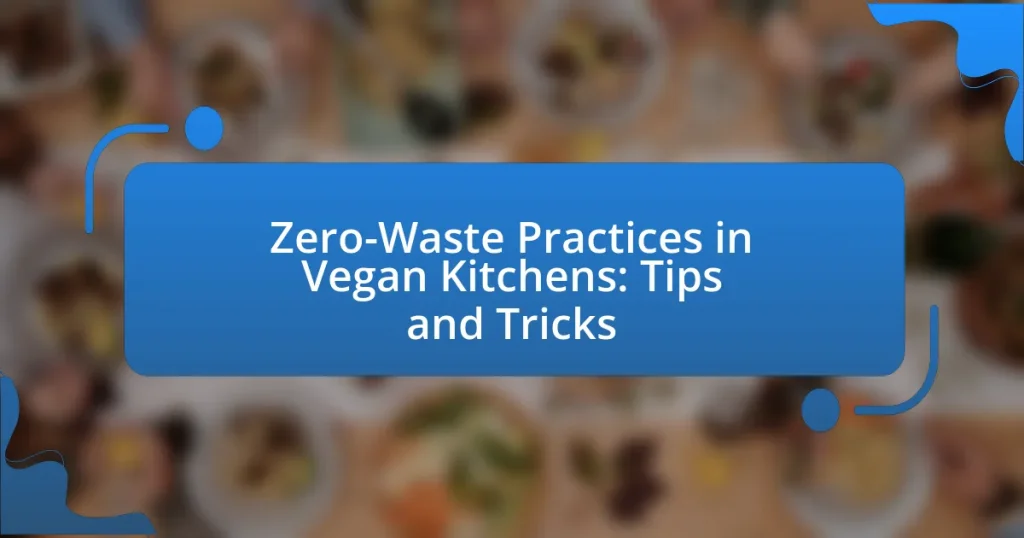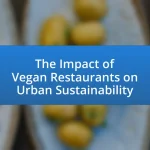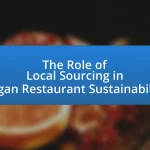Zero-waste practices in vegan kitchens focus on minimizing food waste and maximizing resource efficiency through various strategies. Key practices include utilizing all parts of fruits and vegetables, meal planning, and bulk purchasing to prevent spoilage and reduce waste. The article outlines the alignment of zero-waste principles with vegan cooking, emphasizing sustainability and environmental responsibility. It also provides practical tips for implementing these practices, such as composting, portion control, and creative uses for kitchen scraps, ultimately highlighting the significant environmental benefits of adopting a zero-waste approach in vegan cooking.
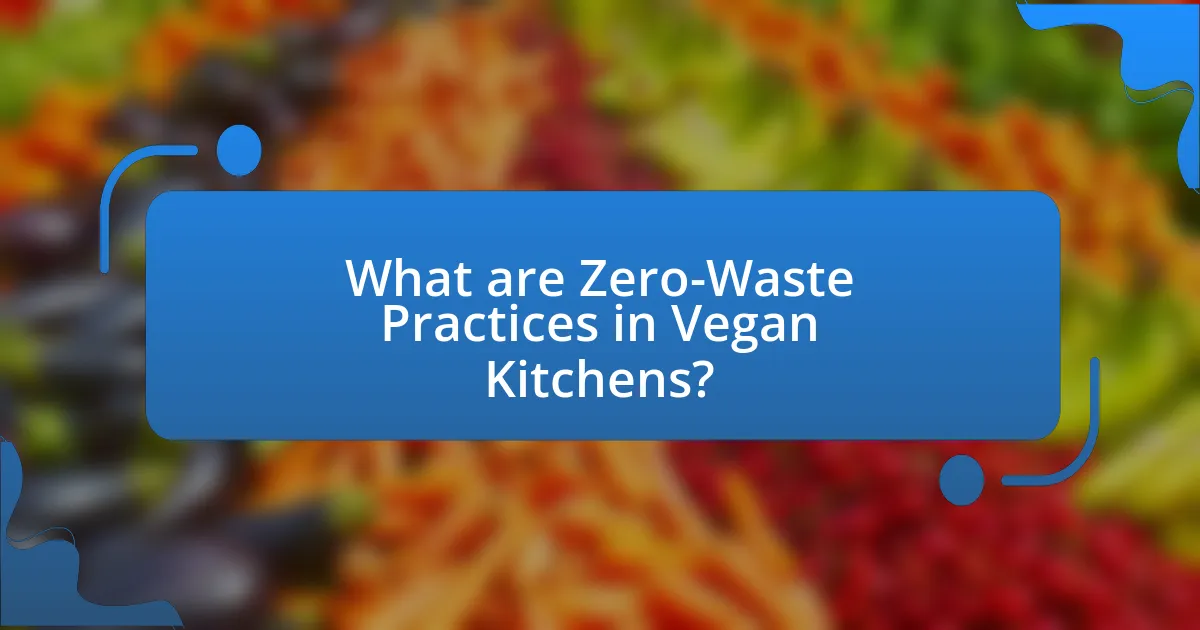
What are Zero-Waste Practices in Vegan Kitchens?
Zero-waste practices in vegan kitchens involve strategies aimed at minimizing food waste and maximizing resource efficiency. These practices include using all parts of fruits and vegetables, such as stems and peels, to create broths or compost, thereby reducing waste. Additionally, meal planning and bulk purchasing help in avoiding overbuying and spoilage, which are significant contributors to food waste. According to the Food and Agriculture Organization, approximately one-third of food produced globally is wasted, highlighting the importance of such practices in promoting sustainability. By implementing these methods, vegan kitchens can significantly reduce their environmental impact while maintaining a plant-based diet.
How do zero-waste practices align with vegan cooking principles?
Zero-waste practices align with vegan cooking principles by emphasizing the reduction of food waste and the use of plant-based ingredients. Both approaches prioritize sustainability; vegan cooking eliminates animal products, which often require more resources and generate more waste compared to plant-based foods. For instance, a study published in the journal “Nature” found that plant-based diets can reduce greenhouse gas emissions by up to 70% compared to meat-based diets. Additionally, zero-waste practices encourage the use of all parts of fruits and vegetables, such as using vegetable scraps for broths or composting, which complements the resourcefulness inherent in vegan cooking. This synergy promotes environmental responsibility and efficient resource use, making both practices mutually reinforcing.
What are the core principles of zero-waste cooking?
The core principles of zero-waste cooking include minimizing food waste, utilizing all parts of ingredients, and composting organic materials. Minimizing food waste involves careful meal planning and portion control to ensure that food is not discarded. Utilizing all parts of ingredients means using stems, leaves, and peels that are often thrown away; for example, carrot tops can be used in pesto. Composting organic materials allows for the recycling of food scraps back into the soil, promoting sustainability. These principles collectively aim to create a more sustainable cooking practice that reduces environmental impact.
How does a vegan diet contribute to sustainability?
A vegan diet contributes to sustainability by significantly reducing greenhouse gas emissions associated with animal agriculture. Research indicates that livestock production is responsible for approximately 14.5% of global greenhouse gas emissions, primarily due to methane and nitrous oxide released during digestion and manure management. By eliminating animal products, a vegan diet decreases the demand for resource-intensive meat and dairy, leading to lower carbon footprints. Additionally, plant-based diets typically require less land and water; for instance, producing one kilogram of beef requires about 15,000 liters of water, while producing one kilogram of vegetables requires only about 300 liters. This efficient use of resources supports environmental conservation and promotes a more sustainable food system.
Why is it important to adopt zero-waste practices in vegan kitchens?
Adopting zero-waste practices in vegan kitchens is crucial for minimizing environmental impact and promoting sustainability. Vegan kitchens already aim to reduce harm to animals and the planet, and integrating zero-waste principles further enhances this commitment by reducing food waste, conserving resources, and lowering carbon footprints. For instance, according to the Food and Agriculture Organization, approximately one-third of all food produced globally is wasted, contributing significantly to greenhouse gas emissions. By implementing zero-waste strategies, such as composting, utilizing all parts of ingredients, and reducing packaging, vegan kitchens can play a vital role in addressing these issues while fostering a more sustainable food system.
What environmental benefits come from reducing kitchen waste?
Reducing kitchen waste leads to significant environmental benefits, including decreased greenhouse gas emissions and reduced landfill use. When food waste decomposes in landfills, it produces methane, a potent greenhouse gas that contributes to climate change. According to the Environmental Protection Agency, food waste accounts for approximately 22% of municipal solid waste, highlighting the potential for emissions reduction through waste minimization. Additionally, reducing kitchen waste conserves resources such as water and energy used in food production, transportation, and processing, further mitigating environmental impact. By implementing zero-waste practices, kitchens can contribute to a more sustainable ecosystem.
How can zero-waste practices enhance the vegan cooking experience?
Zero-waste practices can enhance the vegan cooking experience by promoting creativity and resourcefulness in ingredient usage. By minimizing food waste, cooks are encouraged to utilize every part of fruits and vegetables, leading to innovative recipes and flavors. For instance, vegetable scraps can be transformed into broths or compost, while overripe fruits can be used in smoothies or baked goods. This approach not only reduces environmental impact but also fosters a deeper connection to food and cooking, as individuals become more mindful of their consumption habits. Studies show that adopting zero-waste methods can lead to a more sustainable kitchen, aligning with the ethical principles of veganism.
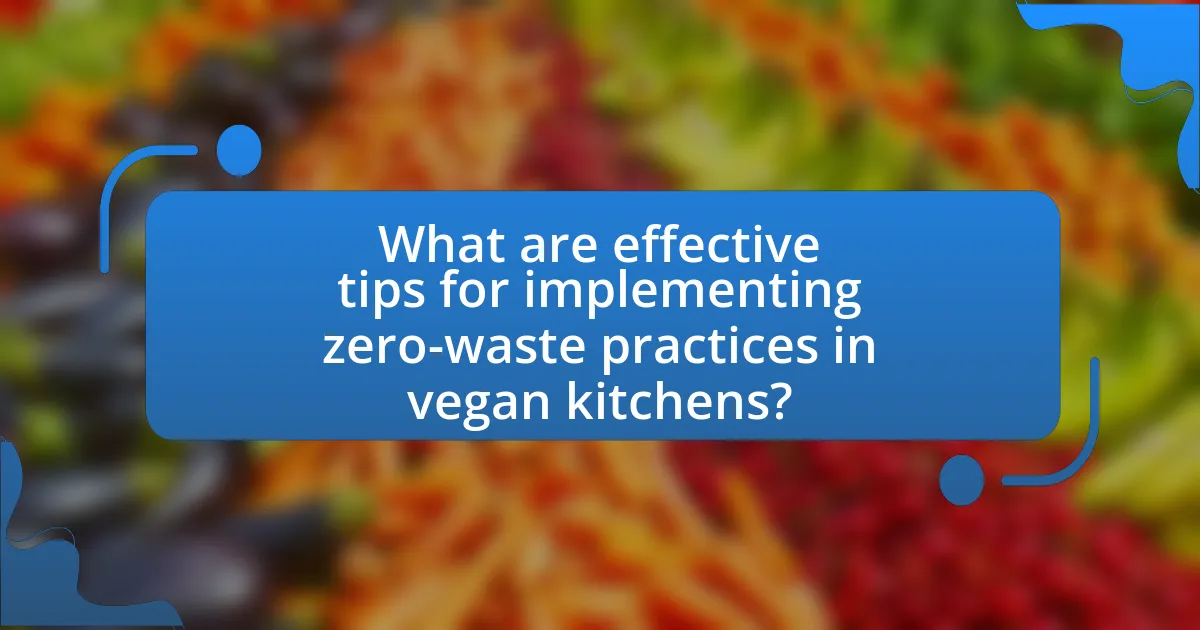
What are effective tips for implementing zero-waste practices in vegan kitchens?
Effective tips for implementing zero-waste practices in vegan kitchens include utilizing all parts of fruits and vegetables, composting organic waste, and opting for bulk purchasing to minimize packaging. Utilizing all parts of produce reduces food waste; for example, vegetable scraps can be used to make broths. Composting organic waste diverts it from landfills, enriching soil and reducing methane emissions. Bulk purchasing allows for the use of reusable containers, significantly cutting down on single-use packaging. According to the Food and Agriculture Organization, approximately one-third of food produced globally is wasted, highlighting the importance of these practices in reducing overall waste.
How can meal planning reduce waste in vegan cooking?
Meal planning can significantly reduce waste in vegan cooking by ensuring that ingredients are used efficiently and in their entirety. By creating a structured plan for meals, cooks can purchase only the necessary quantities of ingredients, minimizing excess that may spoil or go unused. Research indicates that meal planning can lead to a reduction in food waste by up to 50%, as it encourages the use of leftovers and prevents impulse buying of unnecessary items. This strategic approach not only conserves resources but also promotes a more sustainable cooking practice within vegan kitchens.
What strategies can be used for effective meal prep?
Effective meal prep strategies include planning meals in advance, utilizing seasonal ingredients, and batch cooking. Planning meals allows individuals to create a shopping list that minimizes food waste by ensuring only necessary ingredients are purchased. Utilizing seasonal ingredients not only enhances flavor but also reduces the carbon footprint associated with transportation. Batch cooking, which involves preparing large quantities of food at once, helps in portioning meals for the week, thereby reducing the likelihood of food spoilage. These strategies collectively contribute to a more sustainable and efficient approach to meal preparation in vegan kitchens.
How does portion control play a role in minimizing waste?
Portion control significantly minimizes waste by ensuring that food is prepared and served in amounts that match consumption needs. When individuals or kitchens accurately gauge the appropriate serving sizes, they reduce the likelihood of leftovers that may go uneaten and eventually discarded. Research indicates that proper portion sizes can lead to a decrease in food waste by as much as 20-30%, as smaller portions encourage consumption without excess. This practice not only conserves resources but also aligns with sustainable cooking principles, making it a vital strategy in zero-waste vegan kitchens.
What are some creative ways to use kitchen scraps in vegan recipes?
Creative ways to use kitchen scraps in vegan recipes include making vegetable broth from leftover peels, stems, and cores, which utilizes scraps that would otherwise be discarded. Additionally, carrot tops can be blended into pesto, while onion skins can add color and nutrients to dishes. Citrus peels can be candied or used to infuse flavor in beverages. Potato peels can be baked into crispy snacks, and leftover greens can be sautéed or added to smoothies. These practices not only reduce waste but also enhance the nutritional value and flavor of meals.
Which vegetable scraps can be repurposed for new dishes?
Vegetable scraps that can be repurposed for new dishes include carrot tops, beet greens, onion peels, celery leaves, and potato peels. Carrot tops can be blended into pesto, while beet greens can be sautéed or added to salads. Onion peels can be used to create a flavorful broth, and celery leaves can enhance soups or salads. Potato peels can be baked into crispy snacks. These practices not only reduce waste but also maximize the use of the entire vegetable, contributing to sustainable cooking methods.
How can leftover ingredients be creatively combined?
Leftover ingredients can be creatively combined by utilizing them in versatile dishes such as stir-fries, soups, or salads. For instance, vegetables that are nearing spoilage can be sautéed with grains like quinoa or rice, creating a nutritious meal while minimizing waste. Additionally, leftover fruits can be blended into smoothies or baked into desserts, ensuring that no food goes unused. This approach not only reduces waste but also encourages culinary experimentation, as combining various ingredients can lead to unique flavor profiles and textures.

What tools and resources can support zero-waste practices in vegan kitchens?
Tools and resources that support zero-waste practices in vegan kitchens include reusable containers, compost bins, and bulk food purchasing options. Reusable containers, such as glass jars and silicone bags, help minimize single-use plastic waste by allowing for the storage of leftovers and bulk ingredients. Compost bins facilitate the recycling of organic waste, turning food scraps into nutrient-rich compost for gardening. Bulk food purchasing options, available at many grocery stores, reduce packaging waste by allowing consumers to buy only the quantities they need. These practices collectively contribute to a more sustainable kitchen environment, aligning with the principles of zero waste.
What kitchen tools are essential for reducing waste?
Essential kitchen tools for reducing waste include reusable containers, compost bins, and sharp knives. Reusable containers allow for the storage of leftovers and bulk ingredients, minimizing food waste. Compost bins facilitate the disposal of organic waste, turning it into nutrient-rich compost instead of sending it to landfills. Sharp knives enable efficient food preparation, reducing the likelihood of waste due to improper cutting or handling. These tools collectively contribute to a more sustainable kitchen environment by promoting the efficient use of resources and minimizing waste generation.
How do reusable containers and bags contribute to zero-waste cooking?
Reusable containers and bags significantly contribute to zero-waste cooking by minimizing single-use plastic waste and promoting sustainable food storage. These containers and bags can be used repeatedly, reducing the need for disposable packaging that often ends up in landfills. For instance, a study by the Environmental Protection Agency indicates that plastic waste accounts for approximately 12% of municipal solid waste, highlighting the impact of reducing single-use items. By opting for reusable options, individuals can effectively lower their environmental footprint while maintaining food freshness and organization in their kitchens.
What role do composting tools play in a zero-waste kitchen?
Composting tools are essential in a zero-waste kitchen as they facilitate the efficient recycling of organic waste into nutrient-rich compost. These tools, such as compost bins, tumblers, and kitchen scraps containers, enable users to collect food scraps and yard waste, reducing landfill contributions. According to the Environmental Protection Agency, composting can divert approximately 30% of waste from landfills, significantly lowering greenhouse gas emissions. By utilizing composting tools, individuals can transform waste into a valuable resource for gardening, thus promoting sustainability and enhancing soil health.
Where can one find resources and communities focused on zero-waste vegan cooking?
One can find resources and communities focused on zero-waste vegan cooking through online platforms such as social media groups, dedicated websites, and forums. For instance, Facebook hosts numerous groups like “Zero Waste Vegan” and “Vegan Zero Waste Cooking,” where members share recipes, tips, and experiences. Websites such as Zero Waste Chef and The Minimalist Baker provide valuable content on zero-waste cooking practices, including recipes that minimize food waste. Additionally, platforms like Reddit have subreddits such as r/ZeroWaste and r/Vegan, where users discuss sustainable cooking methods and share resources. These communities and resources collectively support individuals interested in adopting zero-waste vegan cooking practices.
What online platforms offer recipes and tips for zero-waste vegan cooking?
Online platforms that offer recipes and tips for zero-waste vegan cooking include Love Food Hate Waste, Minimalist Baker, and The Zero Waste Chef. Love Food Hate Waste provides resources focused on reducing food waste through creative cooking ideas and meal planning. Minimalist Baker features simple, quick recipes that often utilize leftover ingredients, promoting a zero-waste approach. The Zero Waste Chef emphasizes sustainable cooking practices, sharing recipes that minimize waste and encourage the use of all parts of fruits and vegetables. These platforms collectively support the goal of reducing waste in vegan cooking through practical advice and innovative recipes.
How can local communities support zero-waste initiatives?
Local communities can support zero-waste initiatives by organizing educational workshops that teach residents about waste reduction strategies. These workshops can cover topics such as composting, recycling, and sustainable shopping practices, which are essential for minimizing waste. Research indicates that communities that engage in educational outreach see a significant increase in participation in recycling programs, with studies showing up to a 30% rise in recycling rates when residents are informed about proper practices. Additionally, local governments can implement policies that incentivize businesses to adopt zero-waste practices, such as tax breaks for those that reduce packaging waste. By fostering a culture of sustainability through education and supportive policies, communities can effectively contribute to the success of zero-waste initiatives.
What are some practical tips for maintaining a zero-waste vegan kitchen?
To maintain a zero-waste vegan kitchen, focus on reducing food waste, utilizing reusable items, and composting organic materials. Implement meal planning to minimize excess purchases and use all parts of fruits and vegetables, such as stems and peels, to create broths or snacks. Opt for bulk buying to reduce packaging waste, and store food in glass containers to avoid single-use plastics. Additionally, composting scraps can significantly decrease landfill contributions, as organic waste makes up about 30% of what we throw away. By following these practices, a zero-waste vegan kitchen can be effectively maintained.
